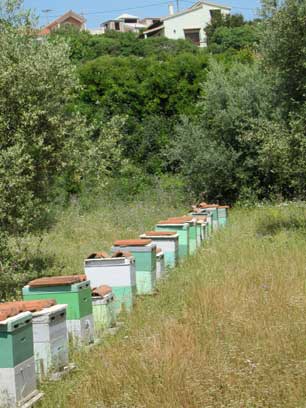Traditional agriculture was the mother of human culture and societies. Small farmers raised food and created organized societies and states. In ancient Greece, small farmers invented democracy and the polis. They also defended the state. Xenophon, an Athenian general, a student of Socrates, and philosopher of late fifth century BCE, praised agriculture as the mother of all the arts and sciences and civilization.(1)
However, the fall of the Greeks and the Romans and the following Dark Ages transformed agriculture more to the liking of plantation owners who worked the land with slaves. Then the nineteenth-century “industrial” revolution added mechanical power to the plantation and, thus, the industrialized version of agriculture came into being. This is a mechanical powerhouse that has been remaking modern science and society to serve the interests of large landowners and industrialists. The damage of this monstrous institution has been monumental, even threatening the survival of the Earth.
There are fundamentally two reasons why industrialized agriculture has broken its ties with civilization. First, it causes a violent revolution by wiping out rural culture and traditions, mechanizing the countryside and making it a subsidiary of urban power. And, second, industrialized agriculture is deleterious to the natural world.
The poisons of industrialized farming, especially pesticides, seep into our food and drinking water, causing us debilitating and fatal diseases. They also kill insects and insect-eating birds. In addition, pesticides and the massive machinery of giant agriculture simplify and degrade ecosystems and, in some cases, do away with them altogether. For example, when we “convert” a forest or wetland to farmland, we obliterate a galaxy of life that thrived in the ecosystem of the forest and wetland. However, industrialized agriculturalists or businessmen don’t think of ecology. They convince themselves that their machines, chemicals and empires of flat land will make them rich. Their vision of the world is confined to how much they can extract from that land. Brazil is wrecking the Amazon to produce soybeans for the animal farms of Western Europe and America. This massive destruction of nature is also going on in the rest of the world, just like mining companies in West Virginia and China blow up entire mountains to get to the coal and other “resources.”
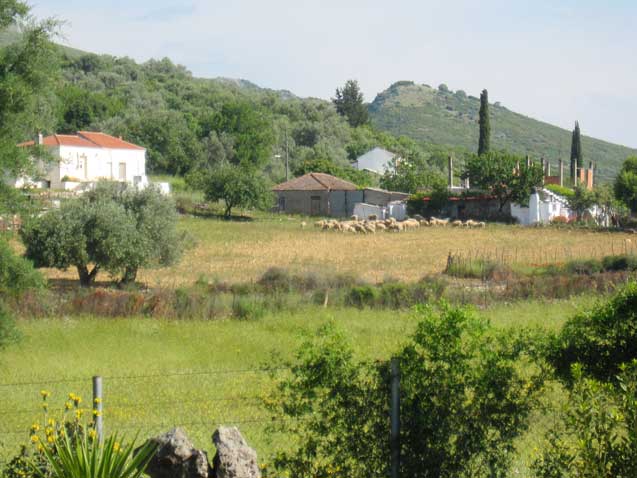 Very small farm, Maxairas, Central Greece. (Photo: Evaggelos Vallianatos)
Very small farm, Maxairas, Central Greece. (Photo: Evaggelos Vallianatos)
These violent effects – social, medical and ecological – are slowly becoming evident, the more rural people move to the cities and the more scientists study the massive transformation of societies and the planet. In the United States, for example, rural sociologists are facing a dead end as they have no more rural people or agrarian institutions to study. Rural America is rural in name only. What used to be small hamlets and towns earning a living from growing food have largely become ghosts that haunt the empires of industrialized agriculture.
You visit rural America and you see vast stretches of empty land: no borders or fences or trees between pieces of land, no land devoted to wildlife. You see abandoned homes falling apart. When the crops are growing, the land is full of the same crop for as far as the eye can see.
The most threatening of the deleterious consequences of large industrialized agriculture is its dependence, indeed addiction, to petrochemicals. These chemicals take the form of petroleum for running the vast mechanical armature of plantations and animal farms, fueling the trucks that transport animals to slaughter and additional trucks carrying food sometimes thousands of miles from farms to cities. Petroleum also becomes pesticides without which the entire agribusiness would grind to a halt. To the owners of large farms, however, the most valuable asset of pesticides is that they enable them to own huge territories – and, therefore, “control” the natural world. The insecticidal and herbicidal properties of pesticides are incidental.
 Large carrot field, Coachella Valley, southern California. (Photo: Evaggelos Vallianatos)
Large carrot field, Coachella Valley, southern California. (Photo: Evaggelos Vallianatos)
Pesticides are biocides that cause tremendous harm to all living things, including man. They decimate endangered species.(2) They poison outright useful insects like honeybees, which pollinate some 90 crops in America. These 90 crops make up a third of the food we eat.(3)
In addition, pesticides disrupt the endocrine system responsible for the healthy development of the newly born animal or infant. These endocrine-disrupting chemicals mess up the “hormonal and homeostatic systems that enable the organism to communicate with and respond to its environment.”(4) The consequences of such disruption are serious. Endocrine-disrupting chemicals undermine the neurological and immune systems of both humans and animals, causing behavioral and reproductive abnormalities and metabolic disorders like diabetes and cancer and other debilitating diseases that last for generations. About 60 percent of the herbicides used in America, for example, are potentially endocrine-disrupting chemicals, which are especially deleterious to the newly born and children.(5)
Pesticides also cause cancer more often to the farmers, farm workers and those living close to farms. For example, Shelia H. Zahm, a scientist who worked for the division of cancer etiology of the US National Cancer Institute, reported in 1990 that farmers of the Midwest suffered from “high cancer mortality rates.”(6) The tragedy continues all over the world. Pesticides sow cancer in the farm – and broader society.(7)
Petrochemicals also cause global warming, a calamity threatening all life on Earth.(8) In fact, a substantial amount of the greenhouse global warming gases come from animal farms. More than 50 billion chickens, hogs, sheep, goats, horses, camels, buffalo and cattle are responsible for carbon dioxide, methane, nitrous oxide and ammonia in vast amounts. Some of these animals, especially hogs, chicken and cattle, live their short lives like sardines in a can, emitting even more greenhouse gases than their grass-fed brethren. But in addition, we have crops grown for them, which also add to greenhouse gases. Forests are clear-cut to raise corn and soybeans, the land releasing Earth-warming poisons in great quantities.
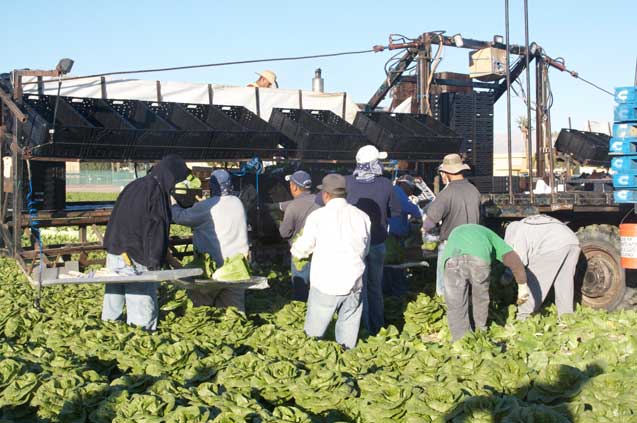 Mexican farm workers harvesting vegetables, Coachella Valley, southern California. (Photo: Evaggelos Vallianatos)
Mexican farm workers harvesting vegetables, Coachella Valley, southern California. (Photo: Evaggelos Vallianatos)
According to “Livestock’s Long Shadow,” a 2006 report of the UN Food and Agriculture Organization, livestock emit about 18 percent of the worldwide amount of carbon dioxide equivalent of greenhouse gases.(9) Two World Bank experts, Robert Goodland and Jeff Anhang, challenged the FAO finding as grossly underestimating the true impact of livestock on global warming. They calculated the greenhouse impact of livestock to be as high as 51 percent of the global emissions of carbon dioxide equivalent in greenhouse gases.(10)
More studies are likely to find a middle course between 18 percent and 51 percent of the livestock’s Earth-warming footprint or a more accurate figure reflecting the true impact of billions of farm animals on the Earth’s climate. Nevertheless, whatever the exact figure may be – and I am tempted to favor the Goodland-Anhang estimate of 51 percent – the livestock greenhouse emissions are extremely worrisome. Not only is industrialized agriculture a major factor in global warming but also global warming promises to disrupt agriculture in probably decisive ways. Drought and diminishing water supplies and decline in the productivity of crops will increase the already unseemly high number of humans who are hungry or facing famine. Meanwhile, livestock’s long shadow is becoming dark. Livestock foul the countryside with huge inequalities(11) and pollute the natural world with vast amounts of excrement, stench and poisonous fumes.(12)
For example, in the 1990s, Smithfield Foods, a giant hog company, sprayed huge amounts of untreated hog waste into the creeks and rivers of North Carolina. This was a larger volume of waste than that of the treated waste for the entire human population of the state. Smithfield’s 9 million hogs’ excrement was equivalent to dumping more than 29,500 metric tons or 64,900,000 pounds of phosphorous every year into the rivers and creeks of North Carolina. This waste has caused devastating environmental damage to the rivers and creeks of North Carolina. In addition, Smithfield buried thousands of dead and drowned hogs in its own sprayed fields every year. The result has been massive contamination of the water, land and air of North Carolina. The worst poisoning of the water took place in the Neuse, Cape Fear and New River.
Environmentalists charged Smithfield Foods with misconduct and abusive practices. They said Smithfield Foods was “reckless, wanton and callous.” Its conduct was “deceptive, immoral, unethical, oppressive, unscrupulous, and substantially injurious.”(13)
No doubt Smithfield Foods committed serious environmental crimes. But this kind of despicable behavior is not limited to Smithfield Foods. Large animal farms pollute hugely and get away with it. For these reasons it’s absolutely necessary to abolish animal farms and change industrialized agriculture, bringing it back to its original form, which had been growing wholesome food with less damage to rural society and the natural world.
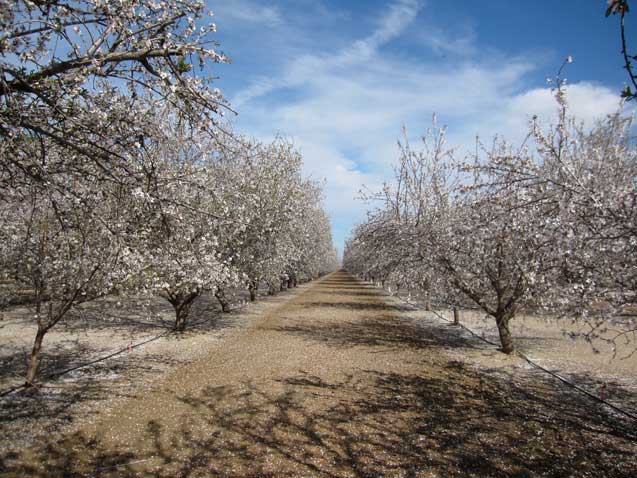 Almond plantation, Central Valley, California. (Photo: Evaggelos Vallianatos)
Almond plantation, Central Valley, California. (Photo: Evaggelos Vallianatos)
In the case of the US, where industrialized agriculture has reached its most threatening state, reform will be difficult. However, the growth of organic farming provides a glimmer of hope for both a strategy and a policy for a democratic and sustainable agriculture that could, theoretically, bring life back to rural America. After all, it took about a century to demolish America’s agrarian edifice for the triumph of the oligarchic agribusiness colossus. Rebuilding rural America and, necessarily, the dismantling of agribusiness, would be revolutionary unless the American people finally see their interest in a new democratic and prosperous small-scale agriculture.
In the case of China, still ambivalent about the role of large-scale industrialized farming, the choice ought to be clear: Rely on the ancient Chinese agrarian traditions of growing food in small farms that mix animals and crops in villages of sustainable communities. This does not mean Chinese agriculture has nothing to learn from ecology and other sciences. On the contrary, the more merged farming becomes with science, the more science is likely to support the scientific wisdom of old traditions.(14)
So far we know: Small farms are as productive per acre as large farms. Small farms are also more efficient in energy and produce healthier food than large farms. Small farms are good for society and the environment(15). They assure a thriving economy and democracy while they protect the health of the natural world. Animals in the farm provide traction power and fertilizers for the land. Healthy land and a variety of crops take care of pests; food growing in small sustainable farms is wholesome and definitely healthier: the larger the farm, the more toxic residues in the food.(16)
In addition, a small farm model for China is also appropriate for social cohesion and peace. You can’t put a billion people in skyscrapers in the cities and still talk of civilization. But more to the point: Who is going to feed those hundreds of millions of city folk? Thus China must have a prosperous and large rural population that will produce sufficient food for all of China. That way, rural China will balance the increasingly concentrated wealth and power of urban China. In the absence of that balance, China is likely to enter a period of strife and class war.
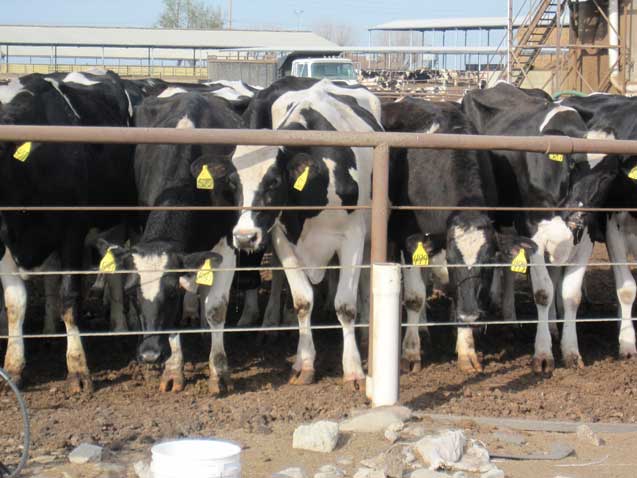 Confined cattle in animal farm, Central Valley, California. (Photo: Evaggelos Vallianatos)
Confined cattle in animal farm, Central Valley, California. (Photo: Evaggelos Vallianatos)
Finally, small farms cool the planet, minimizing the greenhouse emissions of agriculture. In the case of China, small farms would produce smaller amounts of meat, which would reduce China’s enormous and growing amounts of global-warming gases. According to a 2010 report of a group of UNESCO scientists working out of Bangkok, meat production is “a major contributor to global greenhouse gas emissions.”(17) This confirms the 2006 findings of the UN Food and Agriculture Organization.
The example of the US, where the urban sector has practically cannibalized rural America, ought to be a warning on how NOT to do things. America’s great technological talent has made few contributions to improving quality of life in rural America, especially since WWII, when the government and industry nearly merged in making agribusiness the king of the countryside. Yet, American agriculture, mostly the product of very large corporations and extremely rich individuals, has been in perpetual crisis.
Insects and weeds are becoming harder and harder to kill with useless but toxic and polluting chemicals. Neurotoxic pesticides are all but wiping out honeybees(18), but the US Environmental Protection Agency pretends it does not see the connection between systemic neonicotinoid insecticides and the bee kill-offs. Officials and industry propagandists keep talking about honeybee “colony-collapse disorder” in describing the dramatic death rate of honeybees. But a more accurate understanding of what is going on is the straightforward poisoning of honeybees by pesticides. Since the 1970s, bees have been facing neurotoxins everywhere they go for nectar and pollen. Now the systemic neonicotinoid insecticides out of Germany are the last straw.
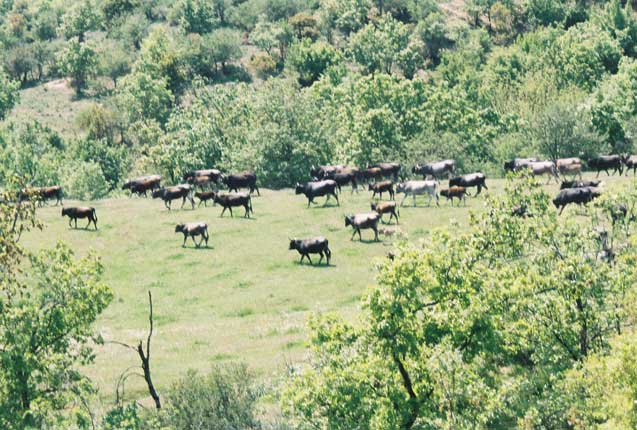 Traditional Greek cattle, Meteora, northern Greece. (Photo: Evaggelos Vallianatos)
Traditional Greek cattle, Meteora, northern Greece. (Photo: Evaggelos Vallianatos)
Meanwhile, the extensive use of genetically modified crops, which relies on weed killers, is disrupting beneficial microorganisms in the soil responsible for the movement of essential nutrients like zinc and iron to the hair roots of crops. This results in crops with diminished nutrition value. In addition, diseases strike the genetically vulnerable crops all over the country. Hundreds of scientists from the government and the country’s 65 agricultural universities are constantly putting out fires in the countryside. That way, they service the country’s rural oligarchy – a few medieval-like agricultural barons and princes who think they control nature and society. After all, their large farms and animal factories produce more than 90 percent of the country’s food.
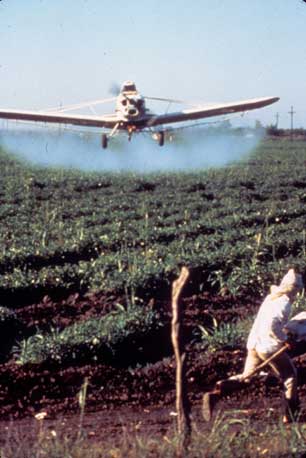 Spraying agricultural pesticides, unknown place. (Photo: Greenpeace)The price for this political and ecological anarchy is the corruption of science and the decline of democracy in America. Not only are agricultural machines and chemicals incompatible with living organisms but, increasingly, agriculture is encroaching on the little land remaining to wildlife. The countryside, home of rural culture and the natural world, is in dire straits in America.
Spraying agricultural pesticides, unknown place. (Photo: Greenpeace)The price for this political and ecological anarchy is the corruption of science and the decline of democracy in America. Not only are agricultural machines and chemicals incompatible with living organisms but, increasingly, agriculture is encroaching on the little land remaining to wildlife. The countryside, home of rural culture and the natural world, is in dire straits in America.
The countryside, however, is more than the domain of America’s rural oligarchy. The countryside of America and of all other countries is absolutely essential for the survival of the natural world. The health of people depends on the health of the natural world. Foul nature as industrialized agriculture has been doing for decades and you threaten the Earth. Paul Ehrlich, professor of biological sciences at Stanford University, put it this way: “breaches of environmental security [like those caused by industrialized agriculture] could risk the end of global civilization.”(19) Thus, maintaining a healthy natural world is in the best interests and security of people and societies. It is, or ought to be, at the core of civilization.
The original version of this paper was presented at the 7th International Forum on Ecological Civilization: Rural Development, Pitzer College, Claremont, California, April 26-27, 2013.
Notes:
1. Xenophon, Oeconomicus 5.1-20, ed. and tr. Sarah B. Pomeroy (Oxford: Clarendon Press, 2001).
2. Justin Augustine and Curt Bradley, “Notice of Violations of the Endangered Species Act Related to the Registration of Pesticides” (San Francisco: Center for Biological Diversity, January 27, 2010).
3. David Pimentel, “Environmental and Economic Costs of the Application of Pesticides Principally in the United States,” Environment, Development and Sustainability, (2005) 7: 229-252.
4.Evanthia Diamanti-Kandarakis et al., “Endocrine-Disrupting Chemicals: An Endocrine Society Scientific Statement,” Endocrine Reviews, 30 (4): 293-345 (2009).
5.Theo Colborn et al., eds., Environment Endocrine-Disrupting Chemicals: Neural, Endocrine, and Behavioral Effects (Princeton, NJ: Princeton Scientific Publishing, 1998); P. Short and Theo Colborn, “Pesticide Use in the U.S. and Policy Implications: A Focus on Herbicides,” Toxicology and Industrial Health: An International Journal, Vol 15, Nos.
6. The Use and Regulation of Lawn Care Chemicals, Hearing, Subcommittee on Toxic Substances, Environmental Oversight, Research and Development, Senate Committee on Environment and Public Works, March 28, 1990 (Washington, DC: Government Printing Office, 1990); A. Blair and Shelia H. Zahm, “Agricultural Exposures and Cancer,” Environmental Health Perspectives, 103 (Suppl 8): 205-208 (1995).
7. D. M. Schreinemachers, “Birth Malformations and Other Perinatal Outcomes in Four U.S. Wheat-Producing States,” Environmental Health Perspectives, 111 (9), 1259-1264 (2003); M. Sanborn et al., Systematic Review of Pesticides: Human Health Effects, Ontario College of Family Physicians, 2004; Samuel S. Epstein, Cancer-Gate: How to Win the Losing Cancer War (Amityville, New York: Baywood Publishing Company, 2005); US National Cancer Institute, Cancer Trends Progress Report, 2007; Molly Jacobs and Dick Clapp, Agriculture and Cancer: A Need for Action (Boston School of Public Health and Lowell Center for Sustainable Production, 2008; S-J Lee et al., “Acute Pesticide Illnesses Associated with Off-target Pesticide Drift from Agricultural Applications – 11 States, 1998-2006,” Environmental Health Perspectives, 119 (8), 1162-1169 (2011).
8. James Hansen, Storms of my Grandchildren (New York: Bloomsbury, 2009); Al Gore, “Climate of Denial: Can science and truth withstand the merchants of poison?” Rolling Stone, June 22, 2011; Bill McKibben, “Global Warming’s Terrifying New Math: Three simple numbers that add up to global catastrophe – and that make clear who the real enemy is,” Rolling Stone, July 19, 2011.
9. H. Steinfeld et al., Livestock’s Long Shadow (Rome: UN Food and Agriculture Organization, 2006).
10. Robert Goodland and Jeff Anhang, “Livestock and Climate Change,” World Watch, November / December 2009, 10-19.
11.Tom Philpott, “Charts: How Big Pork Screws Small Towns,” Mother Jones, Nov. 12, 2012.
12. Robin Marks, Cesspools of Shame (New York: Natural Resources Defense Council and Clean Water Network, July 2001); Rolf U. Halden and Kellogg J. Schwab, Environmental Impact of Industrial Farm Animal Production (A Report of the Pew Commission on Industrial Farm Animal Production, [2007].
13. State of North Carolina, Wake County, Neuse River Foundation, Inc. et al, Plaintiffs, v. Smithfield Foods, Inc. et al, Defendants, In the General Court of justice, Superior Court Division, August 2000.
14.Miguel Altieri, “For an Agriculture that Doesn’t Get Rid of Farmers,” NACLA Report on the Americas, Vol XXXV, No 5, March / April 2002, 29-34.
15. Bill Liebhardt, “What is Organic Agriculture? What I Learned From my Transition” (OECD Workshop on Organic Agriculture, 23-26 September 2002, Washington, DC.); David Pimentel et al., “Organic and Conventional Farming Systems: Environmental and Economic Issues” (Report 05-1, College of Agriculture and Life Sciences, Cornell University, July 2005; David Pimentel, “Reducing Energy Inputs in the Agricultural Production System,” Monthly Review, July-August 2009.
16.Evaggelos Vallianatos, This Land is Their Land: How Corporate Farms Threaten the World (Monroe, Maine: Common Courage Press, 2006).
17. Robert A. Kanaly et al., Energy Flow, Environment and Ethical Implications for Meat Production (Bangkok, Thailand: UNESCO, 2010)
18.Henk Tennekes, The Systemic Insecticides: A Disaster in the Making (Zutphen, The Netherland: ETS Nederland BV, 2010, 5, 70-71.
19. Paul R. Ehrlich and Anne H. Ehrlich, “Can a collapse of global civilization be avoided?” Proceedings of the Royal Society, B 2013, 280, 20122845, 8 January 2013.
Join us in defending the truth before it’s too late
The future of independent journalism is uncertain, and the consequences of losing it are too grave to ignore. We have hours left to raise the $12,0000 still needed to ensure Truthout remains safe, strong, and free. Every dollar raised goes directly toward the costs of producing news you can trust.
Please give what you can — because by supporting us with a tax-deductible donation, you’re not just preserving a source of news, you’re helping to safeguard what’s left of our democracy.
